
Sir Antony Mark David Gormley is a British sculptor. His works include the Angel of the North, a public sculpture in Gateshead in the north of England, commissioned in 1994 and erected in February 1998; Another Place on Crosby Beach near Liverpool; and Event Horizon, a multipart site installation which premiered in London in 2007, then subsequently in Madison Square in New York City (2010), São Paulo, Brazil (2012), and Hong Kong (2015–16).
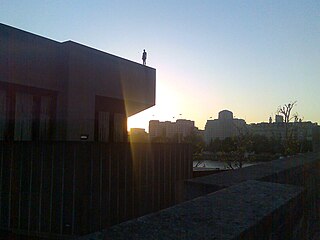
Event Horizon is the name of a large-scale public sculpture installation by the British artist Antony Gormley. First displayed in London in 2007, they were later displayed in New York, downtown São Paulo and Rio de Janeiro, Brazil. Gormley describes his statues as "...showing solitary figures installed in groups yet retaining their sense of solitude and reflection."
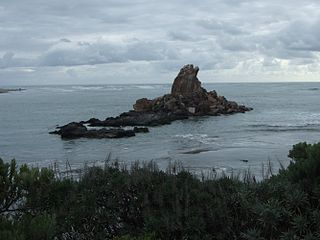
Shag Rock, also known as Rapanui, is a notable sea stack that marks the entrance of the Avon Heathcote Estuary near Christchurch, New Zealand. It is a prominent landmark for navigators at sea as well as travelers on the road to Sumner. The rock stands close to the southern shore just above the low tide level. In the February 2011 Christchurch earthquake it shattered and the remains, which are still easily seen from the road, have, with dark humour by some locals, been called "Shag Pile".

The Christchurch Art Gallery Te Puna o Waiwhetū, commonly known as the Christchurch Art Gallery, is the public art gallery of the city of Christchurch, New Zealand. It has its own substantial art collection and also presents a programme of New Zealand and international exhibitions. It is funded by Christchurch City Council. The gallery opened on 10 May 2003, replacing the city's previous public art gallery, the Robert McDougall Art Gallery, which had opened in 1932.

The Avon River / Ōtākaro flows through the centre of the city of Christchurch, New Zealand, and out to an estuary, which it shares with the Ōpāwaho / Heathcote River, the Avon Heathcote Estuary / Ihutai.

The Twelve Local Heroes is a series of bronze busts located in the central city of Christchurch, New Zealand on Worcester Boulevard outside the Arts Centre to commemorate twelve local Christchurch people who were prominent in their respective fields in the latter part of the 20th century.

Christchurch Central City or Christchurch City Centre is the geographical centre and the heart of Christchurch, New Zealand. It is defined as the area within the Four Avenues and thus includes the densely built up central city, some less dense surrounding areas of residential, educational and industrial usage, and green space including Hagley Park, the Christchurch Botanic Gardens and the Barbadoes Street Cemetery.

Francis Neil Dawson is a New Zealand sculptor, best known for his large-scale civic pieces crafted from aluminium and stainless steel, often made using a lattice of natural forms which between them form a geometric whole.

Oxford Terrace Baptist Church is located in the Christchurch Central City on a prominent corner property fronting the Avon River. The original building was significantly damaged in the 2010 Canterbury earthquake and collapsed in the subsequent February 2011 Christchurch earthquake. This building had a Category II listing by the New Zealand Historic Places Trust. A new building was opened on Christmas Eve 2017.

The Meeting Place is a 9-metre-high (30 ft), 20-tonne (20-long-ton) bronze sculpture that stands at the south end of the upper level of St Pancras railway station. Designed by the British artist Paul Day and unveiled in 2007, it is intended to evoke the romance of travel through the depiction of a couple locked in an amorous embrace.
Wayne Youle is a New Zealand artist of Ngapuhi, Ngati Whakaeke and Ngati Pakeha descent. His bicultural heritage is reflected in his work, addressing issues of identity, race and the commodification of cultural symbols. He often uses humour to make his point. Youle's work is held in national museums and public galleries. He lives and works in Amberley, New Zealand.

Julia Morison is a New Zealand artist working across a wide range of media including painting, sculpture, photography, installation and recently ceramics.

The Margaret Mahy Playground is a playground in the Christchurch Central City on the banks of the Avon River.
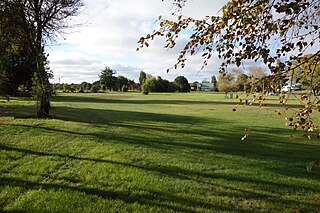
East Lake is an open water course under consideration in Christchurch, New Zealand. The facility, located within the residential red zone adjacent to the Avon River, would be suitable for international rowing regattas. The facility is estimated at NZ$160m to construct.

The Canterbury Earthquake National Memorial is the Crown's official memorial for those killed or seriously injured in the 22 February 2011 Christchurch earthquake. It is located on both sides of the Avon River downstream from the Montreal Street bridge. The memorial opened on 22 February 2017, the sixth anniversary of the earthquake.
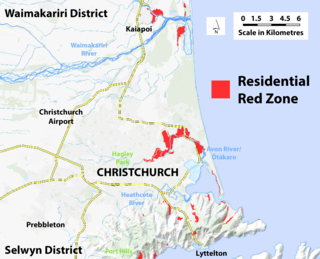
The residential red zone refers to areas of land in and around Christchurch, New Zealand, that experienced severe damage in the 2010 and 2011 Christchurch earthquakes and were deemed infeasible to rebuild on. Through voluntary buyouts, the Crown acquired and demolished or removed over 8,000 properties. The majority were located in a broad swath of the eastern suburbs along the Avon River / Ōtākaro that had suffered damage from soil liquefaction.

Riccarton House is an historic building in Christchurch, New Zealand. It is part of the Riccarton estate, the first area in Christchurch lived in by white settlers, after which the suburb of Riccarton is named. The house was commissioned by Jane Deans, the widow of Canterbury pioneer John Deans, and finished in 1856. It was twice extended; first in 1874, and the work carried out in 1900 more than doubled the size of the house. The Riccarton estate has in stages become the property of Christchurch City Council and Riccarton House itself was sold by the Deans family to the city in 1947. Damaged by the earthquakes in 2010 and 2011, the repaired and renovated building was reopened in June 2014. Riccarton House is used as a restaurant and for functions, and a popular market is held on Saturdays in front of it.
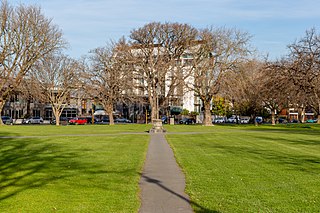
Latimer Square is an urban park in central Christchurch, New Zealand. It is located 400 metres (440 yd) east of the city's centre, Cathedral Square. Many commemorative events take place in Latimer Square. The square lies between the major urban thoroughfares of Gloucester Street and Worcester Street. Madras Street runs north and south to Latimer Square. The square is grassed and crossed by concrete paths and edged by mature trees. It covers an area of a little over 1.8 hectares.
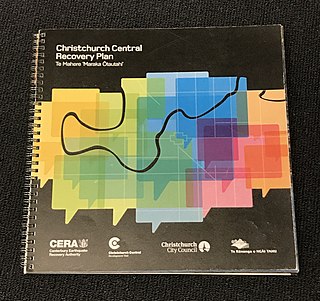
The Christchurch Central Recovery Plan, often referred to as the Blueprint, is the plan developed by the Fifth National Government of New Zealand for the recovery of the Christchurch Central City from a series of earthquakes, in particular the February 2011 Christchurch earthquake. The Canterbury Earthquake Response and Recovery Act 2010 required the Christchurch City Council to develop a recovery plan for the central city. The plan, known as Share an Idea, was presented to the Minister for Canterbury Earthquake Recovery, Gerry Brownlee, in December 2011. Brownlee rejected the city council's plan, established the Canterbury Earthquake Recovery Authority (CERA), and tasked that organisation with developing a plan based on the city council's draft. The Christchurch Central Recovery Plan was published in July 2012 and defined 17 anchor projects. All projects where a timeline was specified were to have been finished by 2017; none of the 17 projects have been delivered on time and some have not even been started yet.

The Bus Interchange is the bus station in the Christchurch Central City in New Zealand. Built as one of the 17 anchor projects identified in the Christchurch Central Recovery Plan, it opened in May 2015 after the previous Bus Exchange had been damaged in the 2011 Christchurch earthquake.




















